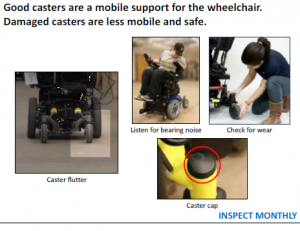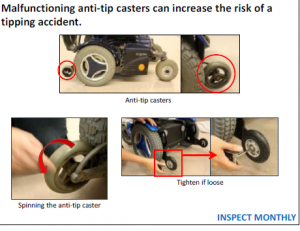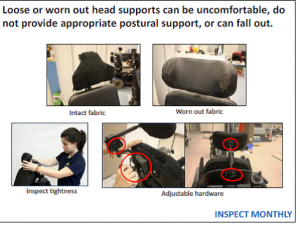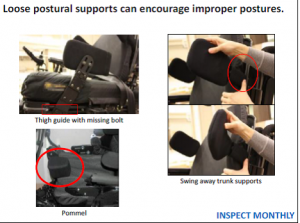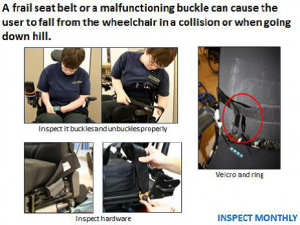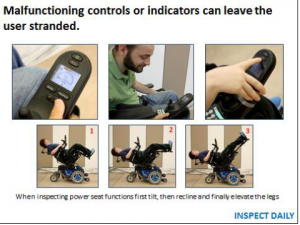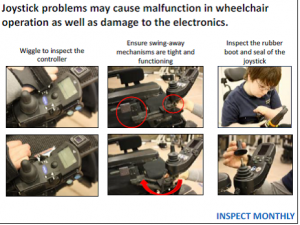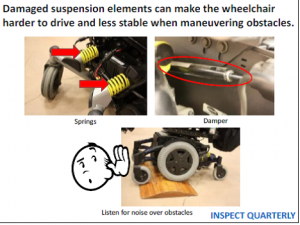Wheelchair and cushion care is important because it saves costs for repairs, extends their lives and prevents injuries and long-term damage to the user’s body. A wheelchair which is cared for will be more comfortable, energy-efficient and easier to use. A cushion which is cared for will continue to provide pressure relief and support. [1]
Between 5 and 18% of wheelchair users experience wheelchair-related injuries each year. Causes of wheelchair-related injuries include tipping over and wheelchair malfunction. In fact, wheelchairs that are poorly maintained increase the risk of their users being injured due to a wheelchair breakdown. Wheelchair users who maintain their wheelchair are 10 times less likely to sustain an injury than those who do not maintain it. repairs and replacement costs account for 30% of the direct wheelchair expenditures annually. [2]
All wheelchairs require periodic maintenance to operate properly. Some wheelchair parts require periodic repair and replacement. [2] Wheelchair maintenance involve periodic inspection and action. wheelchair service providers must provide training and education for users to detect problems, provide periodic care and should supply them with contact details of repairing professionals. Periodic maintenance can be classified into inspection and action steps. Inspection means looking for a problem and an action is trying to fix the problem. [2]
Plastic covers or shrouds protect the electronics and battery of the wheelchair. Always keep protective plastic covers (“shrouds”) in place. If the shrouds are damaged, dirt and moisture can impact the proper function of the wheelchair.
Brake failure is a serious problem that can result in severe injury. If you feel that your brakes are not working properly, you can try the following strategies to inspect them:
The motors are the heart of any power wheelchair. They convert the electrical energy of the batteries to mechanical work. In many cases one motor is used to drive each wheel.
For pneumatic (inflatable) tires if the tire lacks sufficient pressure, the wheelchair will be difficult to maneuver and less stable. The tire and wheel will also wear much more quickly.
Nuts and bolts that are too loose will loosen further or not hold the part properly.
The wheels have a profound effect on the performance of the wheelchair. Drive tires can be pneumatic tires or solid.
- Check for wear on the drive tires.
- When tread depth is low it can easily lead to power chair slippage, making braking distances longer. Wear can also negatively impact the maneuverability and stability of the wheelchair. Therefore replace the tires as early as possible when they are found to have insufficient tread depth.
- Contact a wheelchair maintenance expert to do so.
- This inspection should be performed monthly.
Casters
The casters have an important effect on the performance of the wheelchair.
- Check for wear, cracks, and bulges on the caster wheels. Wear can negatively impact the maneuverability and stability of the wheelchair.
- Caster stem housing should be aligned vertically.
- Check while driving the wheelchair for wobbling of caster wheel and looseness.
- Check for caster flutter. Fluttering is the term used to describe the shimmy or rapid vibration of the caster wheels. Excessive flutter can cause the wheelchair to move in an unwanted direction. This might cause a collision and injure the user. Contact a wheelchair maintenance expert to get repaired.
- Bearings will wear out on a caster wheel during normal use. Problems in the bearings are identified when noises like clicking or grinding are present. They need to be replaced before they fail.
- Caster wheels wear out faster than the drive tires.
- This task should be performed monthly.
Anti-Tips
Anti-tip wheels may be located in the front or rear of the wheelchair. When they are in use and properly adjusted, if the wheelchair begins to tip over it is caught by the anti-tip casters. Therefore, they can help to prevent some tipping accidents.
- Check that the anti-tip wheels are not loose and do not squeak or drag.
- If wheels are loose, tighten any screws until snug using an Allen wrench, open end box end wrench.
- Inspect that there are no cracks or the wheels are not wore out.
- If problems are identified, contact wheelchair maintenance expert to get the anti-tip replaced.
- This task should be performed monthly.
Cushion
Cushions are a very important component of the wheelchair and do not last as long as the frame. The interaction between the cushion and the body determines the user’s comfort, function, and clinical safety. Deterioration in the cushion can increase the risk of developing a pressure ulcer.
Remove the cover so you can inspect both cushion and cover.
Look for tears or holes in the cover or zipper malfunction, which might expose the cushion surface or create a wrinkled sitting surface.
If the cover contains a foam liner, look for tears or flaking in the foam.
The bottom of most covers has a Velcro or a nonskid surface. Inspect this surface for worn or torn Velcro or breakdown of the non-skid material.
The cover is designed to protect the cushion, so it should be replaced if damaged.
After inspecting the cover inspect the cushion for shape and contour.
This should be done weekly.
There are many types of cushions. Depending on the type there are signs you should look for:
Keep air cushions properly inflated and inspect that the valve is in good condition and does not leak. If you suspect that there is a leak, remove the cover and submerge the cushion in water and look for bubbles.
A rubber air cushion (e.g. ROHO) can be patched using a patch kit.
When you travel by air pay special attention to the cushion because the pressure will change and always travel with a patch kit.
If you have a gel cushion, knead the gel daily from the outer perimeter to the middle of the cushion. Inspect that the gel is not hard and that there are no leaks.
If you have a foam cushion, inspect that the foam is intact and not deteriorated and chipping. When you press it, it should bounce back.
If the cushion has a solid seat insert, check that it is not broken
Armrest
The primary purpose of the arm support is to provide good resting posture for the arms. In addition, arm supports provide a form of support and are convenient handles when the rider leans to one side or the other. They are also helpful when attempting to reach higher places, and they also assist some people with transfers.
Arm supports can be fixed or adjustable. Most can be removed or flipped out of the way in order to provide clearance for transferring in and out of the wheelchair.
Removable arm supports usually fit into one or two sockets. Commonly, if there are two attachment points, the front socket contains a latch to lock the armrest in place.
Flip back arm supports are hinged at the back near the intersection of the seat and backrest. Some flip back supports use the latch in the front to help secure them in place.
- Inspect that the arm supports are intact, tightened and can be released (if originally designed to do so), put back into place with ease, and latch easily.
- Inspect for sharp edges that could cause harm.
- Loose arm supports can make the user fall when using them for support during transfers.
- Tighten as necessary.
- If a problem is identified, contact the wheelchair maintenance expert.
- This inspection should be performed monthly
Back Support
Back supports provide comfort and postural support while sitting. Back supports can be sling upholstery or rigid.
For Upholstery Back Supports:
- Inspect it for wear, tears, stretched upholstery, or metal parts that may be sticking out.
- Inspect all upholstery rivets or screws and check that the upholstery is not tearing in those spots.
- Loose upholstery may provide less postural support and can lead to skeletal deformities.
- Contact a wheelchair maintenance expert to replace the upholstery when these problems are identified.
- When the upholstery is replaced, it is best to replace the bolts or screws that hold it in place. This will ensure that they are properly maintained as well.
For Rigid Back Supports;
- Inspect the surface is intact.
- Inspect that the back support hardware is properly attached to the back support posts and does not rattle.
- Tighten loose bolts with a screw driver, Allen wrench, or wrench.
- If the fabric is worn out and/or the foam is rigid, contact the wheelchair maintenance expert to get a replacement.
- The back support should be inspected monthly.
Most rigid-frame wheelchairs have a foldable back support for transport and storage. If you have a folding back support, check that the mechanism lock is in place. Loose back supports can be dangerous during transfers because they could move or come out. Always make sure that the back support is locked before using it after unfolding the back. If problems are identified contact your wheelchair maintenance expert to get it fixed or replaced [2]
Head Support
Users may require head and neck supports to provide the necessary stability required to control a power wheelchair and to prevent the head from extending beyond the plane of the back support. This is especially important if the seating system is tilted or reclined.
There are many types of head supports including: flat, flip-down, removable, curved, winged, vertical wedge, U-shaped, lateral, among others.
Head supports are mounted to the seating system using adjustable hardware so that the support can be moved, adjusted, and removed as needed.
- Check that the head support is properly tightened and intact. If the head support is designed to move, it should move freely, but not be too loose that it rattles. Loose and/or worn out head supports can be uncomfortable, do not provide appropriate postural support, or can fall out.
- Tighten loose bolts using an Allen wrench, open end box end wrench.
- Lubrication may be necessary in hinges/movable parts if the supports do not adjust easily.
- If problems are identified contact the wheelchair maintenance expert.
- This inspection should be performed monthly.
Foot supports are used to support the feet and legs. There are different foot supports that can flip up or down, swivel, elevate, or can be removed.
Often the foot supports are the first part of the wheelchair to come in contact with an obstacle. They are used to open doors, act as bumpers, and also scraped along the ground when the wheelchair is loaded into a motor vehicle.
Swing-away foot supports are not as durable as rigid foot support. It is common that swing away foot support bend upon impact.
- Inspect the swing away foot supports, look for wear in the pins, bolts and bushings.
- Inspect that the foot supports are intact, are tightened and can be released (if originally designed to do so), put back into place with ease and latch easily. You can use a screwdriver or wrench or Allen wrench to tighten loose bolts.
- Lubrication may be necessary in hinges/movable parts if the supports do not adjust easily.
- If problems are identified, contact the manufacturer.
- This task should be performed monthly.
Postural Support
Proper seating can improve a person’s stamina and provide greater comfort. Supports are used to align and hold a person in a manner that improves seated posture and alignment while maintaining or improving function. These include: abductor pommels, hip adductors, leg abductors, leg adductors, and lateral trunk supports.
- If the supports are swing-away or flip-up, inspect that they move freely, but are not too loose to rattle.
- If they are fixed, inspect that they are tightened.
- Loose nuts and bolts can eventually work themselves all the way out, and could cause the support to fall off. However, over tightening a loose nut or bolt could damage the housing and/or break the bolt.
- Tighten loose bolts using an Allen wrench, open end box end wrench. After tightening be aware of red spots on the skin that is in contact with the support. If red spots are found, loosen the support and contact the wheelchair maintenance expert.
- Inspect that the fabric and cushioning of the support are intact. Hard supports may be uncomfortable and increase pressure to the skin that they are in contact with. This can increase the risk of pressure sores.
- If problems are identified, contact the wheelchair maintenance expert.
- This task should be performed monthly.
Seat Belt
Pelvic support and positioning can be achieved using a pelvic belt or lap belt, which can prevent or correct a slouching posture and prevent the person from sliding forward on the seat.
- Check that the buckle latches and the hardware that attaches the strap to the frame are undamaged.
- Inspect the strap and velcro (when applicable) for any signs of wear. The strap, buckle, and hardware should all be in good condition. The latch on the belt should not slip or become unlatched inadvertently.
- Contact a wheelchair maintenance expert if problems are identified.
- This task should be performed monthly.
Power Seat Functions
Power seat functions are options that benefit people who are unable to move or reposition themselves effectively independently. These options redistribute pressure, manage posture and tone, provide comfort, and help with personal care activities.
- When inspecting that the power seat functions first tilt, then recline and finally elevate the legs.
- Inspect that the full range of controls, indicators, driving, and horn are working smoothly and consistently.
- If the power seat function(s) malfunctions, the user can be left in an unsafe position for driving or at risk of pressure sores.
- Contact a wheelchair maintenance expert if you identify problems such a grinding noises, jerking, or not working consistently.
- Inspect monthly.
Battery Charger
Batteries are the fuel system for power wheelchairs. If the batteries do not work properly, the wheelchair will not work properly. Maintaining the batteries is vital to the performance of the wheelchair.
- It is important that the appropriate charger be used with each battery set.
- Only use the charger that came with the wheelchair.
- Inspect the battery charger cable.
- This task should be performed monthly.
- If problems are found contact a wheelchair maintenance expert.
Joystick
Joysticks are the most common control interface between the user and the wheelchair. Joysticks and switches can be used to effectively control a power wheelchair. Joystick problems may cause malfunction in wheelchair operation as well as damage to the electronics.
- Turn OFF the controller.
- Check the joystick and rubber boot around the base of the joystick for damage.
- Check that the joystick returns freely to neutral without binding.
- Check that the seal on the joystick is intact; it keeps dirt and water out. Check that all switches and controls are tightly in place.
- Check that the controller clamp holds the joystick firmly in place. If found loose, tighten appropriately.
- Contact a wheelchair maintenance expert immediately if problems are identified.
- This task should be performed monthly
Note: to avoid excessive moisture in the controller: Always carry a gallon plastic bag to cover the joystick and controller if it rains, to prevent moisture accumulation. If the joystick/controller gets wet, use a hair dryer to blow through the charge/controller plug.
Cables
Wires and connectors are part of the wheelchair’s electrical system.
- Check all electrical connections to ensure they are firmly in place and free of grime and corrosion. Connectors can loosen with bumps and vibration.
- Inspect that they are firmly connected. Corrosion can render connectors useless, resulting in motors that will not drive or batteries that will not charge.
- Inspect that all cables and wires are intact.
- Check wires to make sure they are safely away from all moving parts such as belts, gears, and wheels, with no chance of being caught or tangled. It may be necessary to tie cables down to the frame or in a bunch. Use cable ties for this purpose.
- If the wheelchair has power seat functions, ensure that cable ties do not restrict the seat positioning. Wires that become caught in moving parts can become disconnected or even snap.
- Inspect that wires and cables are intact and not frail.
- Contact a wheelchair maintenance expert if problems are identified.
- This task should be performed monthly.
Suspension
Dampers or shock absorber springs are used to improve ride comfort, reduce driving fatigue, and accommodate rough terrain.
- Inspect springs looking for cracks on the paint.
- Inspect that the dampers are not leaking fluid.
- Be aware that when you are going over obstacles, for example a speed bump, the wheelchair does not make noises and it is safe (at least 3 wheels must be in contact with the ground all the time).
- If problems are identified contact your wheelchair maintenance expert.
- If you have had significant changes in weight this may mean that the suspension is not providing the same damping. Contact a wheelchair maintenance expert if you had significant changes in weight.
- Inspect the suspension every 3 months.
Professional Wheelchair Service
Have wheelchair professional serviced at least once a year. In places with inclement weather condition, wheelchairs should be professionally serviced twice a year.
Power Wheelchair Action Maintenance
Clean the Wheelchair and Cushion
To protect metal and wooden parts from rusting and rotting and stop damage caused by dirt scraping against moving parts.
- Use warm water with a little soap.
- Rinse and dry.
- Pay attention to moving parts, and where upholstery joins the frame.
- Remove cushion from cover and wash separately.
- Always dry the cushion in the shade – not in direct sun.
- Remove dirt, lint, and hair from the caster axles bearings with scissors, tweezers, toothbrush, or plyers. Dirt, lint, or hair buildup on the axles and casters can eventually cause premature wear. Hair especially can twist around the bearings and cause breakage.
- This task should be performed monthly [2]
Battery Charger
Batteries are the fuel system for power wheelchairs. If the batteries do not work properly, the wheelchair will not work properly.
Maintaining the batteries is vital to the performance of the wheelchair. Batteries last longer if they are never run completely flat. However, charging too frequently when the batteries have only been used a little will also decrease the batteries’ life. Only the charger provided with the wheelchair should be used. Batteries should be stored fully charged.
A well-maintained battery should last from 1 to 1.5 years.
If the batteries are having difficulty keeping a charge, contact a wheelchair maintenance expert. Batteries must be installed and maintained by a wheelchair maintenance expert.
Power Seat Functions
If the power seat functions malfunction the user can be left in an unsafe position for driving or at risk of pressure sores.
Excessive dirt build-up can make the tracks wear over time and may stop working.
- Clean the power seat functions and all the tracks (including tilt, recline, leg support elevator, and seat elevator) with a dry soft cloth.
- The seat should be at the maximum range.
- CAUTION: If there is grease/lubricant on the track do not clean it.
- This task should be performed monthly

